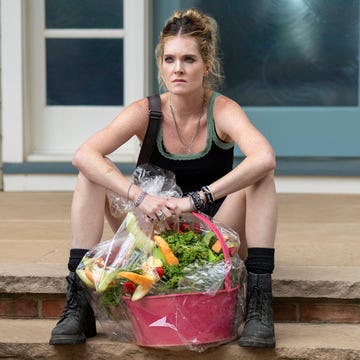There’s no need for a big garden, neatly organised allotment or, in fact, any outdoor space at all – believe it or not, just a windowsill can be enough to get your kitchen garden going, whether you’re naturally green-fingered or not. This is the message that gardener Martha Swales wants everyone to know… and she should know!
‘I didn’t really have a clue what I was doing when I started gardening,’ says Martha. ‘I didn’t have a vegetable patch, so everything I grew in my first year was in containers made from recycled crates with plastic bags in, or in trays on the radiator of my mum’s living room.’
What began as a hobby in her early 20s became an obsession as Martha grew anything and everything she could around her family house and patio. She eventually progressed to an allotment, before finally getting a garden of her own.
In 2020, 15 years after her initial foray into gardening, Martha began sharing clips and tips on how to grow various fruit and veg (plus what to cook with them) on social media, and she took off. Now, she has over a million followers across platforms and her first book, Give It A Grow, a beginners’ guide to gardening, is out this month.
‘No space is too small!’ she says. ‘Even if you only have a small balcony, it’s possible for you to create a little oasis for nature, food and flowers.’
Martha’s guide to what to grow where
…on the windowsill
There are so many different varieties of herbs which are great for the windowsill, like garlic greens (which I whizz up into an oil to make aioli, or add to omelettes and flatbreads), and microgreens like cress, which are ideal for sandwiches or garnishing soup. I often buy herbs like mint from the supermarket and split them up into smaller containers in the kitchen, so they’re close to hand for mojitos.
From March you can start growing salad leaves on the windowsill too – I really like mustard leaves and lentil greens, which I use to make daal. You can also use your windowsill to start off other plants, including tomatoes and cucumbers, before it’s warm enough to move them outdoors.
…in pots on your patio or balcony
If you’ve got even a small section of outdoor space, whether it’s a patio or a balcony, then you can do wonders with planters and containers (a spare bucket works perfectly if you need something deeper to plant carrots; I like to whizz the up tops into pesto). Plastic containers such as empty mushroom boxes are great for starting off seeds for things like lettuce and peas indoors, before transferring them to outdoor pots.
In March and April, you can start planting more hardy vegetables including carrots, beetroot, spring onion, kale, cabbage, potatoes and broccoli in outdoor containers. It’s worth covering them with some cardboard or left over bubble wrap packaging to start with, just to help keep things warm until the spring weather gets going.
Lettuce can be ripe for picking as early as April, and speedy potato varieties like Charlotte could be ready by the end of May, if you plant them in mid-March. I make a big salad plate out of the first potatoes of spring which I always look forward to. Boil the potatoes and lather them in butter, salt and mayonnaise with chopped radishes.
…in a hanging basket
Hanging baskets aren’t just for flowers – they’re a great environment for just about anything which needs a lot of light to grow, as they tend to get more sun. The added height also makes baskets ideal for anything which trails, like Tumbling Tom tomatoes.
Strawberries can also work brilliantly in hanging baskets (just think of all those lovely summer cheesecakes and crumbles) and small chillies, which are cracking in a homemade curry. Even salad leaves and herbs can suit hanging baskets, as you can treat them like a normal pot. Just remember, you’ll need to water hanging baskets more often than other containers, as they’re spending more time in the sun.
…along a wall
If you’re really short on outdoor floor space, try growing on a trellis against a wall. Climbing beans are an obvious choice for good reason, especially if you have a particularly sunny spot on the wall. I also like to grow tomatoes or cucumbers vertically, and tie them with string to secure them as they grow.
You could also put a set of stacked or tiered shelves against an outside wall to maximise space. Add a selection of different pots to create a pretty display, and plant with radishes, strawberries, tomatoes or spring onions. I grow a French herb salad leaf mix and spicy mustard leaves from seeds in shallow trays along my stacked shelves, which I use to make really delicious and varied salads.
To keep potted plants healthy…
Think about positioning
Light is the one element you can’t control, so think about where you’re putting your pots to make the most of it. Leafy things need the least sunlight, so salads and herbs are good for shady spots. Root vegetables and brassicas (anything in the cabbage family) sit somewhere in the middle, and then anything which produces a fruit – including aubergines, pumpkins and tomatoes – needs plenty of sunshine.
Don’t neglect spacing
Planting things too close together in containers is a common mistake. Even though your seedling or your bulb is tiny now, it will (hopefully!) grow. Spread your plants across multiple pots and leave space around each one rather than packing them side by side. If they’re too close, their roots will end up in tangled competition with each other and you could end up with nothing.
Create your own compost
You don’t need to spend money on bottles of liquid feed. There should be plenty of goodness in a bag of peat-free multi-purpose compost or, even better, your own. I always recommend starting your own compost bin, so you can transform all your potato peelings, tea bags and egg box scraps into natural, nutritious feed for your garden.
The trick with watering
Dip your finger in the soil and if it’s dry, you know you need to water it. Keep an eye out for any water collecting on the top of the soil or underneath the pot and tip away in case you’ve been overwatering (or the rain has drenched it). Usually you’ll only need to check a couple of times a week but, as a general rule, you’ll want to water every day or two in the heat of the summer.
Remember to acclimatise
If you’ve been starting off seedlings or growing tomatoes on the windowsill, don’t just throw them outside in May and expect them to survive. You’ll need to acclimatise them by leaving them out in the day and then bringing them back inside at night for the first week or two, which will help get them used to the new conditions.
Battling pests?
I never use pesticides, but if I’m overrun with slugs and snails, the best thing to do is remove them yourself on an evening when it’s been raining – that’s when they’ll all come out. You can simply scoop them into a bucket and take them away from the garden – perhaps to a park or grassy area elsewhere. It also pays to keep an eye on plant leaves to see if you catch any aphids early. If you do spot some, just wash them away with water.
Tip: Build a bee drinking station
Put some pebbles into a small dish and add a little bit of water. The bees can land on the pebbles and use them to stand on while they refresh themselves with a drink during the summer months.
Give It A Grow (Penguin Life, £18.99) by Martha Swales is out now














